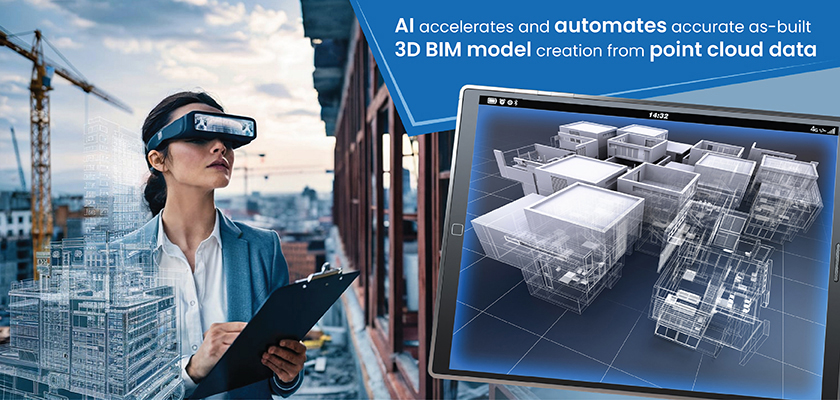
AI in Scan to BIM transforms point cloud processing through intelligent recognition and automation. These systems enhance accuracy, streamline workflows and enable predictive maintenance. Also, machine learning in Scan to BIM delivers unprecedented efficiency for building documentation and management.
Traditional Scan to BIM processes often face challenges like excessive manual processing time, inconsistent accuracy, and difficulties in managing complex geometric data. These issues directly impact project timelines and budgets while compromising design integrity.
AI in Scan to BIM solves these issues by automating point cloud processing, enhancing pattern recognition, and delivering unprecedented modeling accuracy. Implementing machine learning in Scan to BIM helps you reduce modeling time by substantial margins, improve data quality, and create comprehensive digital representations of physical structures.
This transformation is a fundamental shift in how built environment data is captured, processed, and utilized across the project lifecycle.
Table of Contents
Traditional Scan to BIM methods require human interpretation of scans data a process both times consuming and prone to inconsistencies. Manual processes suffer from data overload that overwhelms processing capabilities, difficulty in recognizing non-standard building elements, frequent misclassification of architectural features, and inability to handle partial or occluded scan data effectively.
The transition from manual point cloud processing to AI in BIM workflows began with basic automation tools that could help identify simple geometric shapes. Today’s AI driven architectural modeling systems can process complex point clouds with minimal human intervention, recognizing building elements and converting them into parametric BIM objects automatically.
This evolution delivers measurable improvements in workflow efficiency:
| Aspect | Manual Process | AI-Enhanced Process |
|---|---|---|
| Point cloud registration | Manual alignment requiring extensive QC | Automated registration withFeature detection |
| Element recognition | Manual tracing and modeling from scratch | Automated object classification and generation |
| MEP system identification | Highly time-intensive manual modeling | Pattern-based recognition of system components |
| Parametric object creation | Individual modeling of each instance | Automated generation with standard parameters |
| Level of Detail management | Manually determined for each element | AI-optimized based on element importance |
The applications of this technology extend beyond new construction documentation. AI applications in BIM modeling are particularly valuable for:
This shift from manual to AI in Scan to BIM facilitates compressing timelines while expanding capabilities, making previously impractical projects economically viable.
How AI & ML Are Revolutionizing Scan to BIM Workflows
Discover how AEC professionals are using Artificial Intelligence (AI) and Machine Learning (ML) to dramatically improve the speed, and accuracy of their Scan to BIM processes.
What You’ll Learn:
Unlock the future of intelligent BIM modeling.
Download Now!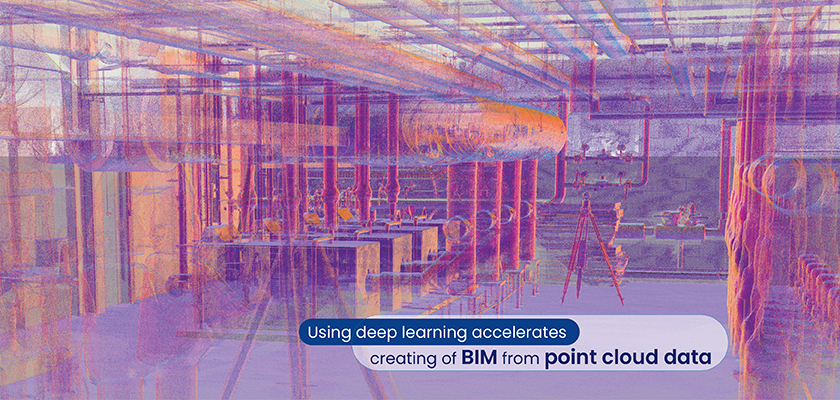
AI and ML for BIM modeling transform the process of translating scan data into usable building information models. The use of neural networks enables the recognition of complex architectural elements with higher precision by analyzing point cloud density patterns, geometric relationships, and contextual positioning simultaneously.
The intelligent recognition process enhances accuracy through the following steps:
AI in 3D laser scanning for BIM helps identify edge conditions and boundary definitions, surface normal’s and planar relationships, and geometric discontinuities indicating different building elements. It also helps in analyzing material textures and visual characteristics and in the easy identification of mechanical and electrical system components.
Machine Learning in Scan to BIM continuously improves as systems learn from each project, refining recognition patterns and expanding object libraries. The result is a substantial improvement in model fidelity without corresponding increases in processing time a direct benefit of intelligent automation in the scan to BIM pipeline.

The integration of machine learning and artificial intelligence into Scan to BIM automation software delivers advantages beyond basic automation.
These advantages of using AI for structure analysis include:
These benefits of ML & AI extend beyond simple time savings, creating a fundamentally more intelligent approach to building documentation and information management. Once trained, AI systems can apply recognition patterns across enormous datasets with minimal additional computational costs. This delivers remarkable scalability benefits for large-scale projects.
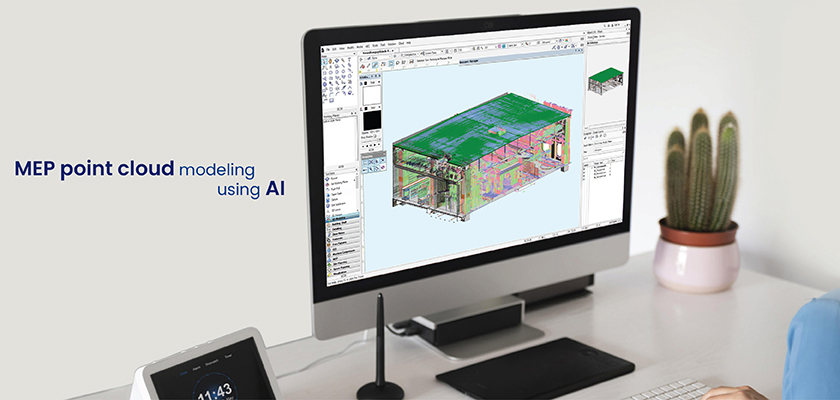
AI in Scan to BIM enables continuous model updates through periodic scanning; creating a dynamic digital representation that accurately reflects current building conditions.
Implementing predictive analytics in construction facilitates previously impossible maintenance capabilities. By comparing sequential scans over time, AI systems can:
By analyzing patterns of degradation or change over time, machine learning algorithms can predict when systems or components may require maintenance or replacement, allowing for proactive rather than reactive facility management approaches.
The result is what can be described as “living BIM models” that reflect current conditions rather than design intent or as-built documentation that quickly becomes outdated. The integration of AI in construction technology with facility management systems creates a continuous information loop that improves building performance, reduces operational costs, and extends the infrastructure lifespan.
Despite the tremendous potential, it is important to understand challenges in point cloud to BIM conversion using AI for successful implementation.
Recommended implementation strategies for automated BIM modeling using AI include:
For example, consider an architecture firm beginning with a single floor office renovation using AI to process point clouds for basic structural elements while manually modeling complex features. The firm establishes a verification protocol requiring human review of all AI generated elements against source data.
After documenting the time saved on basic elements, they expand to multi-floor projects, gradually increasing AI involvement as confidence grows. For each project, the modeling team logs recognition errors, which developers use to refine algorithms for subsequent projects. This methodical approach builds institutional expertise while managing risk.
Resolve Scan to BIM data processing challenges with AI enhanced workflows.
Talk to our BIM experts Now »Point Cloud to 3D BIM Modeling for a Commercial Building
A topographic services company based in Tarragona, Europe sought to renovate a commercial building by demolishing a portion and introducing a new design. The client required an accurate structural 3D model derived from point cloud data to assess the existing structure and perform load calculations for the new design.
Hitech CADD Services developed a 3D BIM model using Revit for an 111,000 m² area, divided into 133 segments. Initially processing 2 segments weekly, productivity increased to 9-10 segments by scaling the team, including modelers and quality controllers. Additionally, we suggested 3D modeling in Revit and exporting the CAD model with standard details and layers.
The final deliverables led to the following:
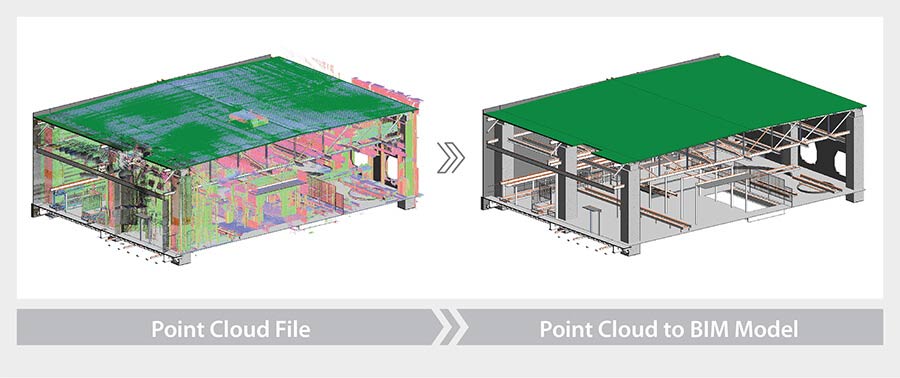
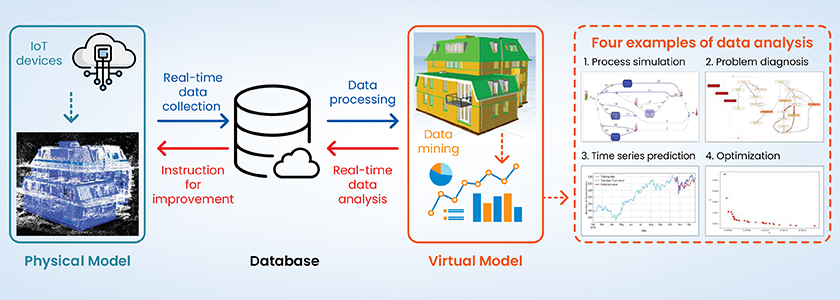
The future of Scan to BIM automation software extends beyond current capabilities, with several transformative developments for the future.
Generative design integration will enable AI in Scan to BIM to suggest design modifications based on performance criteria, spatial analysis and usage patterns. This creates a powerful feedback loop between documentation and design optimization.
Real-time scanning and modeling technologies are rapidly developing, enabling instantaneous conversion of scan data to BIM elements. Visualization of parametric BIM objects in realtime is a possibility, as scanning progresses, accelerating the documentation process.
Deeper semantic understanding will enable AI systems to recognize not just what building elements are but how they function together as systems. This contextual awareness will produce more intelligent models that capture the relationships and dependencies between building components.
Digital twin technology in BIM continues to evolve, creating virtual representations that mirror physical reality and predict future performance based on current conditions and usage patterns. These intelligent models will serve as decision support tools in BIM for facility management, renovation planning and life-cycle cost analysis.
The integration of AI in Scan to BIM creates a fundamental shift in how built environment professionals approach documentation, modeling and building management. These technologies deliver measurable benefits in accuracy, efficiency and data utilization that transform what’s possible in the AEC industry.
Implementing machine learning in Scan to BIM will help you create opportunities for enhanced analysis, prediction and optimization throughout the building lifecycle. Early adoption of these technologies helps you gain competitive advantages through improved deliverable quality, compressed schedules, and expanded service offerings.
You may also like
BIM-Based MEP Coordination for Multi-Trade Collaboration
How AI and ML are Shaping the Future of Scan to BIM
Cabinet Shop Drawings: A Detailed Guide